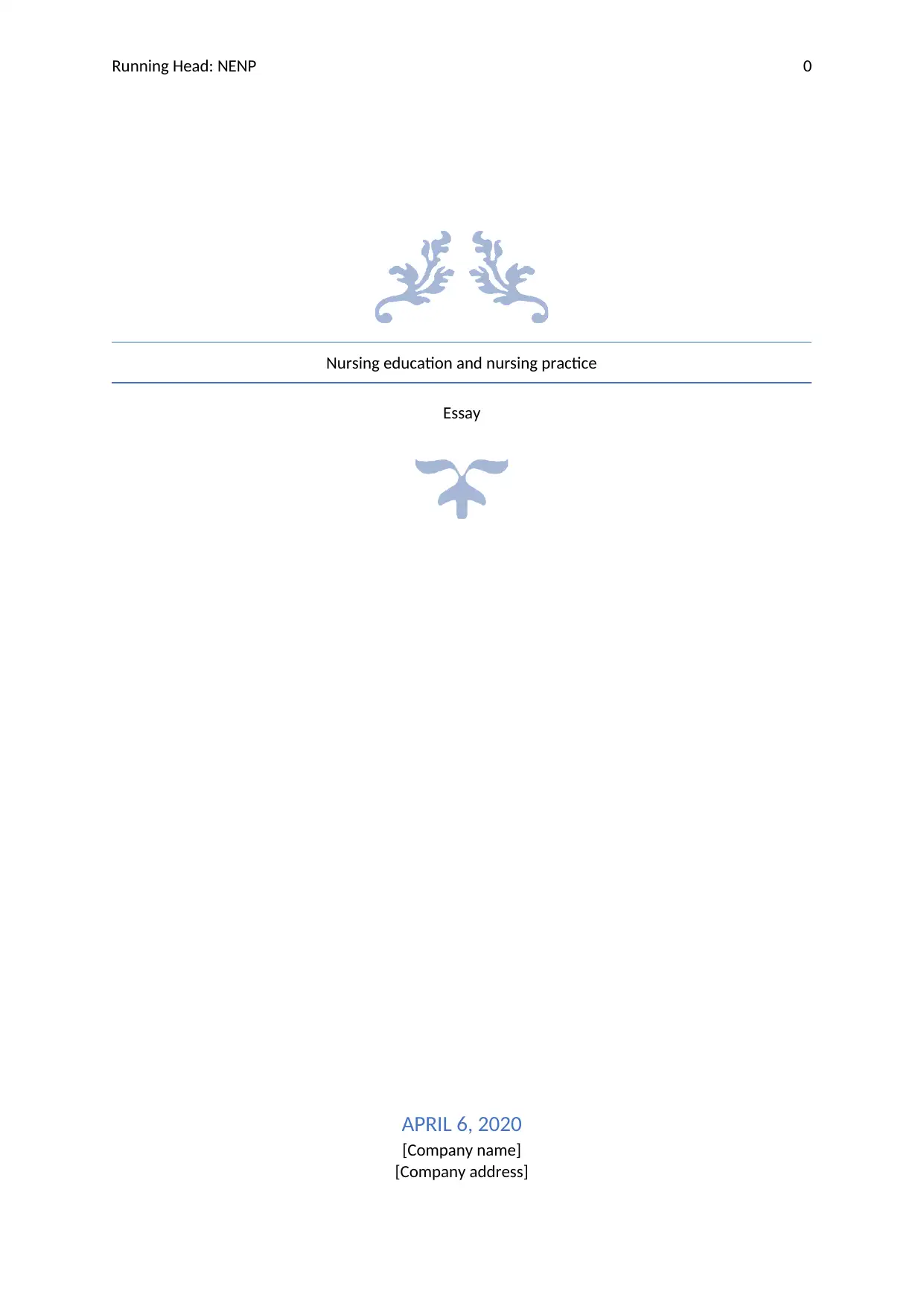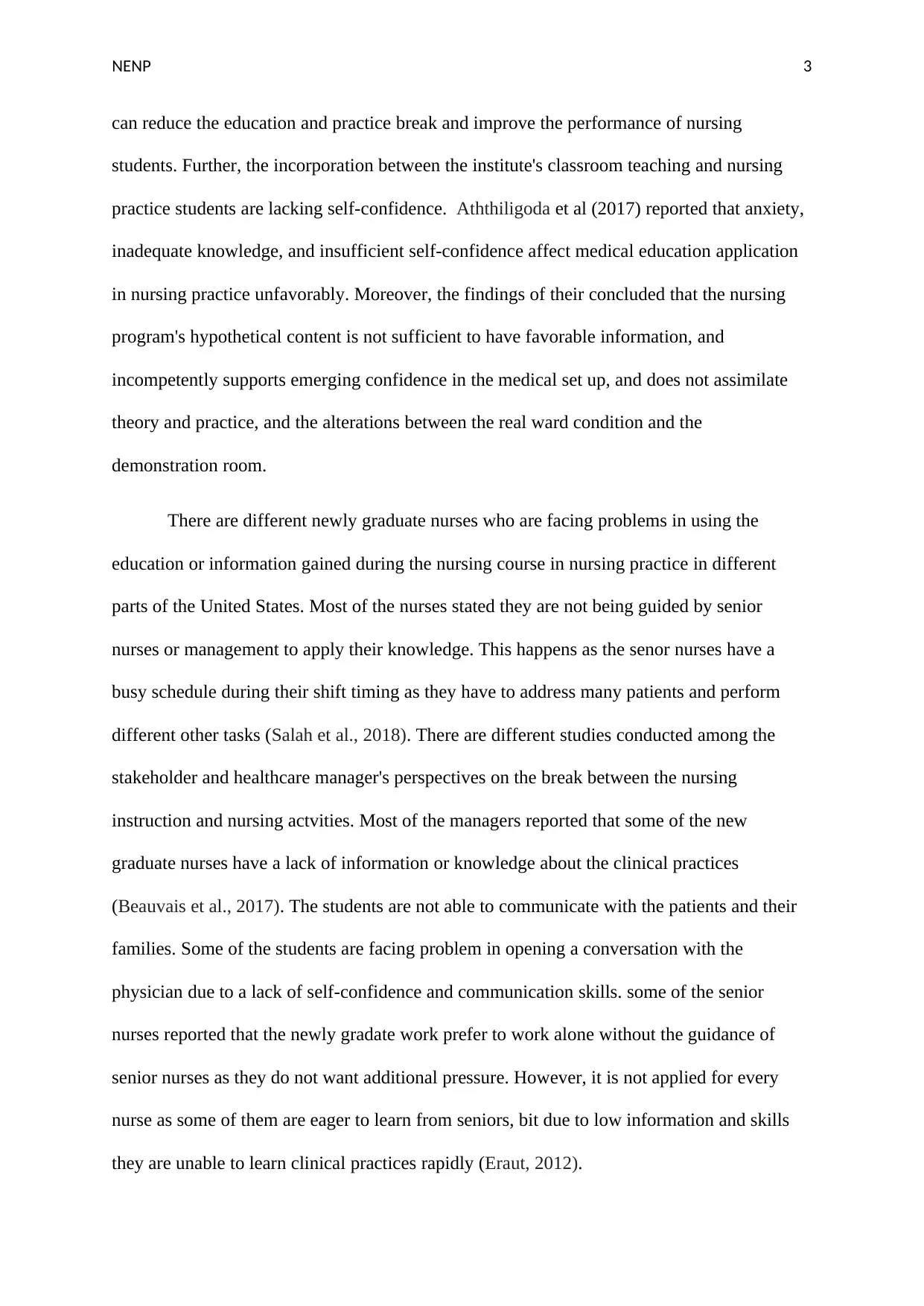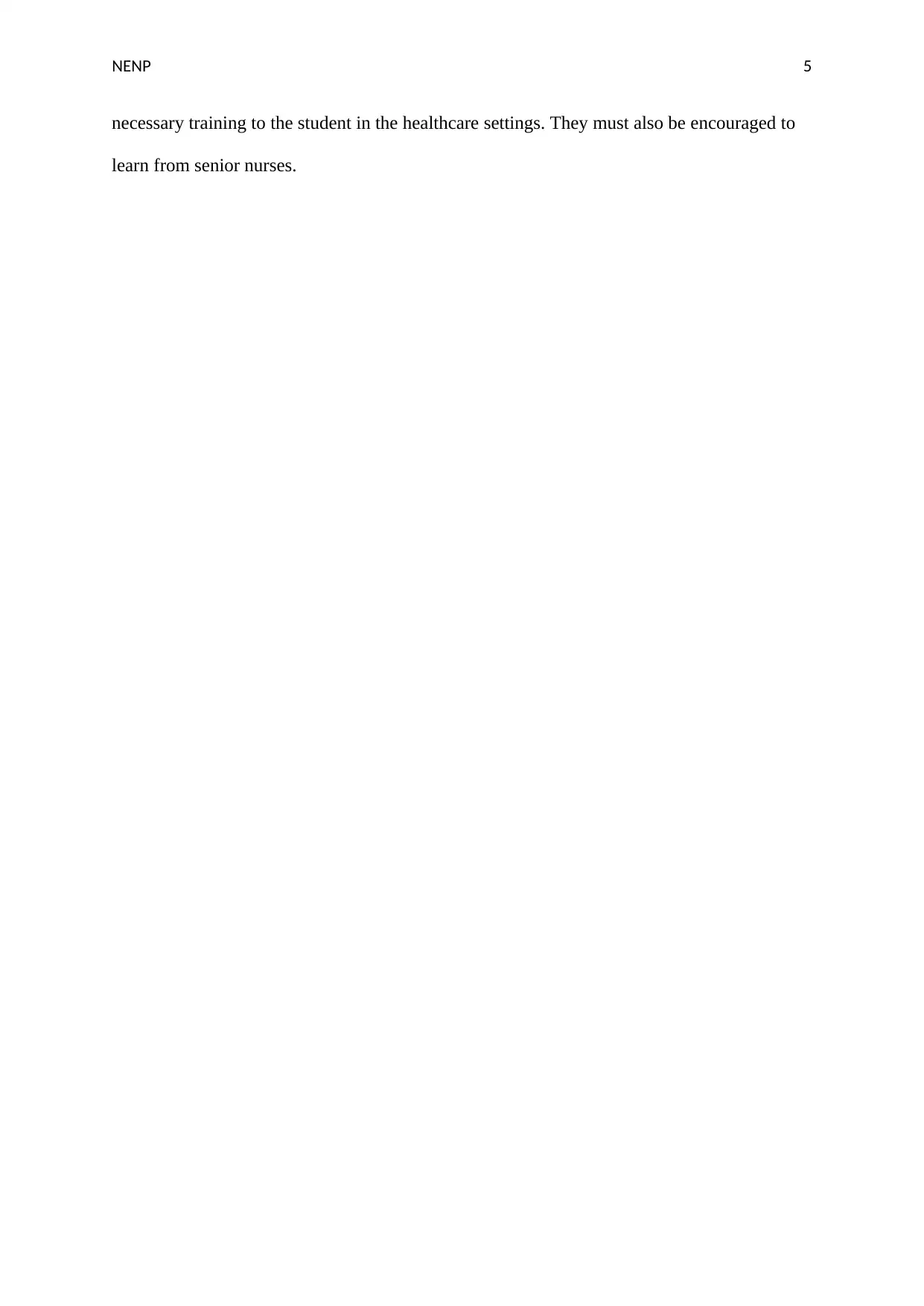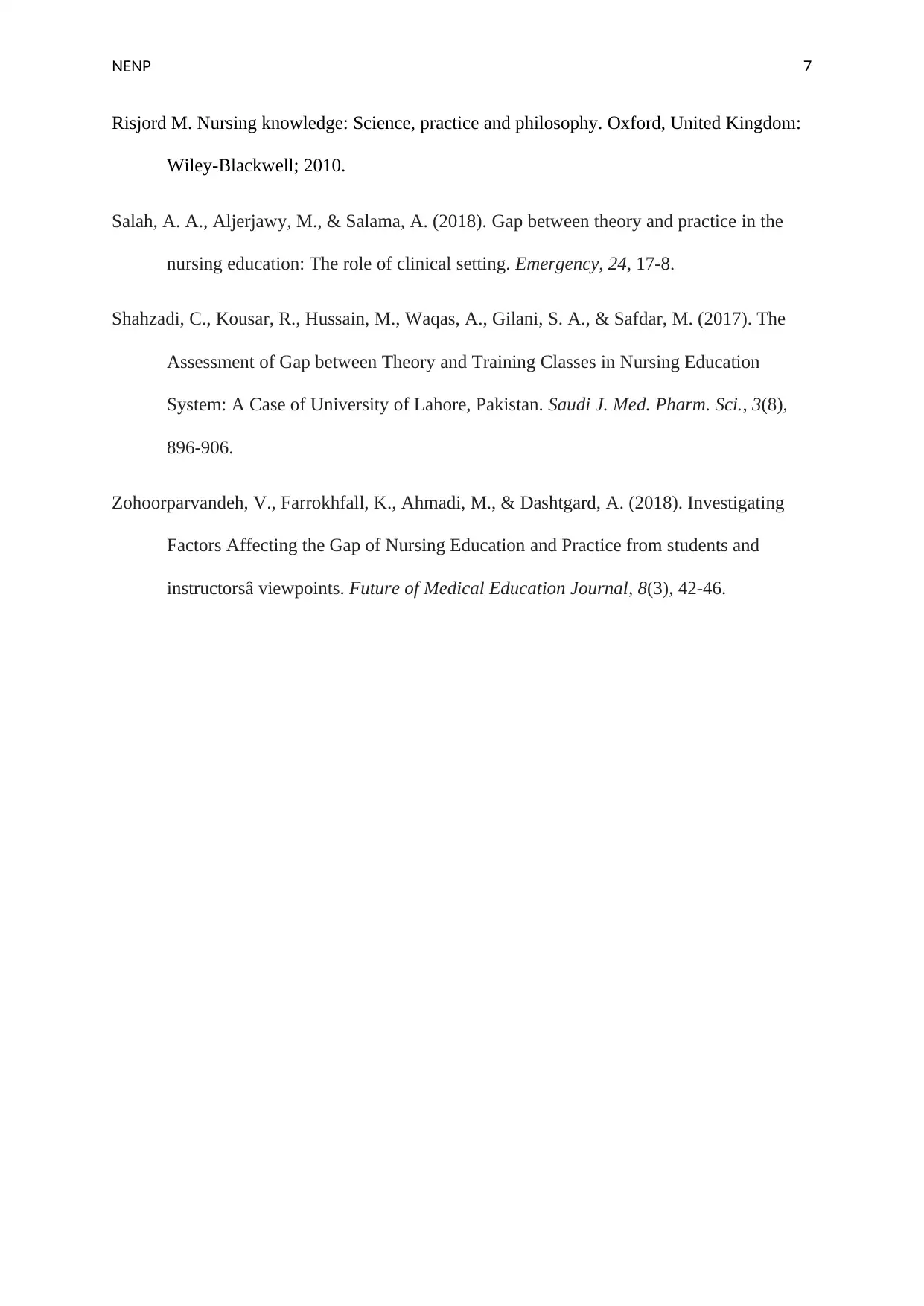NENP 2: Exploring the Gap Between Nursing Education and Practice
VerifiedAdded on 2022/09/10
|8
|2055
|22
Essay
AI Summary
This essay critically examines the significant gap that exists between nursing education and its practical application in clinical settings. It delves into the core differences between theoretical knowledge acquired in classrooms and the realities of nursing practice, highlighting the challenges faced by newly trained nurses. The essay discusses various factors contributing to this gap, including the limited experience of educators, the fast-paced nature of healthcare environments, and the lack of integration between academic learning and real-world scenarios. It also explores the perspectives of stakeholders, including healthcare managers and senior nurses, on the issues faced by new graduates. Furthermore, the essay proposes several strategies to bridge this gap, such as improved communication between educational institutions and clinical settings, the use of evidence-based practices, and the encouragement of mentorship programs. The conclusion emphasizes the importance of collaborative approaches to enhance the preparedness of nurses for their roles, ultimately improving patient outcomes.

Running Head: NENP 0
Nursing education and nursing practice
Essay
APRIL 6, 2020
[Company name]
[Company address]
Nursing education and nursing practice
Essay
APRIL 6, 2020
[Company name]
[Company address]
Paraphrase This Document
Need a fresh take? Get an instant paraphrase of this document with our AI Paraphraser

NENP 1
Nursing education and nursing practice?
Nursing has become an integral part of every healthcare system. It encompasses the
promotion of health, stopping illness, and caring individuals with health issues. nurses are the
core member of every health care team assigned for an ill person, as they spent more time
with the diseased person than any other healthcare professional (Potter et al., 2016). Nurses
perform multiple takes throughout their shifts such as assessment of the patient, assisting the
physician in the treatment process, administrating drugs, and discharging patients. They learn
different skills such as effective communication, having knowledge of different cultures
during their course and apply them in practice (Holloway & Galvin, 2016). Nursing
education and nursing practice are different and This particular essay will discuss the gap
between nursing instruction and nursing practice.
Nursing education and nursing practice are two different things. Nursing education
denotes to formal education and training in the discipline of nursing. This comprises the
functions and responsibilities in the bodily care of patients, and a mixture of dissimilar
disciplines that both quicken the patient's reappearance to health and support maintain it. The
scope of practice in nursing is the variety of roles, purposes, responsibilities, and actions in
which an experienced nurse is educated, knowledgeable and has a specialist to perform
(Holloway & Galvin, 2016). There are different researchers who identified that there is a gap
between nursing instruction and nursing practice. It is also the difference between the leant
abstract information and theory and its usage in practice, and the gap between the scientific
information and theory applied as the mutual practice. In some workplaces, student nurses,
willing to put into nursing practice the newest evidence-based investigation, are rapidly
collapsed when they start work and learn the workplace culture overlooks their wish to
transfer information and discards their efforts at change (Mackey & Bassendowski, 2017).
Nursing education and nursing practice?
Nursing has become an integral part of every healthcare system. It encompasses the
promotion of health, stopping illness, and caring individuals with health issues. nurses are the
core member of every health care team assigned for an ill person, as they spent more time
with the diseased person than any other healthcare professional (Potter et al., 2016). Nurses
perform multiple takes throughout their shifts such as assessment of the patient, assisting the
physician in the treatment process, administrating drugs, and discharging patients. They learn
different skills such as effective communication, having knowledge of different cultures
during their course and apply them in practice (Holloway & Galvin, 2016). Nursing
education and nursing practice are different and This particular essay will discuss the gap
between nursing instruction and nursing practice.
Nursing education and nursing practice are two different things. Nursing education
denotes to formal education and training in the discipline of nursing. This comprises the
functions and responsibilities in the bodily care of patients, and a mixture of dissimilar
disciplines that both quicken the patient's reappearance to health and support maintain it. The
scope of practice in nursing is the variety of roles, purposes, responsibilities, and actions in
which an experienced nurse is educated, knowledgeable and has a specialist to perform
(Holloway & Galvin, 2016). There are different researchers who identified that there is a gap
between nursing instruction and nursing practice. It is also the difference between the leant
abstract information and theory and its usage in practice, and the gap between the scientific
information and theory applied as the mutual practice. In some workplaces, student nurses,
willing to put into nursing practice the newest evidence-based investigation, are rapidly
collapsed when they start work and learn the workplace culture overlooks their wish to
transfer information and discards their efforts at change (Mackey & Bassendowski, 2017).

NENP 2
For nurses, the difference between the hypothetical input learned in the classroom and
what is applied or practiced on the ward leftovers a perennial problem, and nowhere is this
difference is so large as for newly trained students. It is a gap that is unavoidably experienced
by all nurses at several times in their nursing careers, but it is new nurses, given their
beginner status and restricted experience, who possibly struggle most to succeed the theory-
practice negated (Beauvais et al., 2017). According to Risjord (2010), another issue that
contributes to the gap between philosophy and practice in the field of nursing is the restricted
number and experience of afresh hired medical educators.
Several student nurses are looking for jobs that adapt to the traditional shifts’ hours
of 8 am in the morning to 5 pm and weeks off, therefore shortchanging their involvements
and the experiences of a student nurse. Zohoorparvandeh et al (2018), reported that the gap
between instruction and practice is extensive in the nursing career. In the current era, the
parting of philosophy and nursing duties or the difference between instruction and medical
services is recognized as one of the utmost central difficulties and greatest vital issue
associated with the nursing profession and the healthcare system. This is learned in the
institute is dissimilar from the facilities presented at the bedside. Bouchlaghem & Mansouri
(2018) also supported the fact that there is a break between nursing education and nursing
practice. They stated that the difference between philosophy and practice in the filed nursing
instruction is a well-established fact.
The academic information acknowledged in class frequently reduces throughout the
training and actual duties of the nursing profession. They conducted a study in Tunisia and
reported that the gap exists in Tunisia's institution of nursing education curriculum for
example in hand hygiene. Shahzadi et al (2018) conducted a study to identify the gap among
a particular population student and reported a different perspective about the reason for this
gap. They further identified that the lectures in the medical setting are not a high value that
For nurses, the difference between the hypothetical input learned in the classroom and
what is applied or practiced on the ward leftovers a perennial problem, and nowhere is this
difference is so large as for newly trained students. It is a gap that is unavoidably experienced
by all nurses at several times in their nursing careers, but it is new nurses, given their
beginner status and restricted experience, who possibly struggle most to succeed the theory-
practice negated (Beauvais et al., 2017). According to Risjord (2010), another issue that
contributes to the gap between philosophy and practice in the field of nursing is the restricted
number and experience of afresh hired medical educators.
Several student nurses are looking for jobs that adapt to the traditional shifts’ hours
of 8 am in the morning to 5 pm and weeks off, therefore shortchanging their involvements
and the experiences of a student nurse. Zohoorparvandeh et al (2018), reported that the gap
between instruction and practice is extensive in the nursing career. In the current era, the
parting of philosophy and nursing duties or the difference between instruction and medical
services is recognized as one of the utmost central difficulties and greatest vital issue
associated with the nursing profession and the healthcare system. This is learned in the
institute is dissimilar from the facilities presented at the bedside. Bouchlaghem & Mansouri
(2018) also supported the fact that there is a break between nursing education and nursing
practice. They stated that the difference between philosophy and practice in the filed nursing
instruction is a well-established fact.
The academic information acknowledged in class frequently reduces throughout the
training and actual duties of the nursing profession. They conducted a study in Tunisia and
reported that the gap exists in Tunisia's institution of nursing education curriculum for
example in hand hygiene. Shahzadi et al (2018) conducted a study to identify the gap among
a particular population student and reported a different perspective about the reason for this
gap. They further identified that the lectures in the medical setting are not a high value that
⊘ This is a preview!⊘
Do you want full access?
Subscribe today to unlock all pages.

Trusted by 1+ million students worldwide

NENP 3
can reduce the education and practice break and improve the performance of nursing
students. Further, the incorporation between the institute's classroom teaching and nursing
practice students are lacking self-confidence. Aththiligoda et al (2017) reported that anxiety,
inadequate knowledge, and insufficient self-confidence affect medical education application
in nursing practice unfavorably. Moreover, the findings of their concluded that the nursing
program's hypothetical content is not sufficient to have favorable information, and
incompetently supports emerging confidence in the medical set up, and does not assimilate
theory and practice, and the alterations between the real ward condition and the
demonstration room.
There are different newly graduate nurses who are facing problems in using the
education or information gained during the nursing course in nursing practice in different
parts of the United States. Most of the nurses stated they are not being guided by senior
nurses or management to apply their knowledge. This happens as the senor nurses have a
busy schedule during their shift timing as they have to address many patients and perform
different other tasks (Salah et al., 2018). There are different studies conducted among the
stakeholder and healthcare manager's perspectives on the break between the nursing
instruction and nursing actvities. Most of the managers reported that some of the new
graduate nurses have a lack of information or knowledge about the clinical practices
(Beauvais et al., 2017). The students are not able to communicate with the patients and their
families. Some of the students are facing problem in opening a conversation with the
physician due to a lack of self-confidence and communication skills. some of the senior
nurses reported that the newly gradate work prefer to work alone without the guidance of
senior nurses as they do not want additional pressure. However, it is not applied for every
nurse as some of them are eager to learn from seniors, bit due to low information and skills
they are unable to learn clinical practices rapidly (Eraut, 2012).
can reduce the education and practice break and improve the performance of nursing
students. Further, the incorporation between the institute's classroom teaching and nursing
practice students are lacking self-confidence. Aththiligoda et al (2017) reported that anxiety,
inadequate knowledge, and insufficient self-confidence affect medical education application
in nursing practice unfavorably. Moreover, the findings of their concluded that the nursing
program's hypothetical content is not sufficient to have favorable information, and
incompetently supports emerging confidence in the medical set up, and does not assimilate
theory and practice, and the alterations between the real ward condition and the
demonstration room.
There are different newly graduate nurses who are facing problems in using the
education or information gained during the nursing course in nursing practice in different
parts of the United States. Most of the nurses stated they are not being guided by senior
nurses or management to apply their knowledge. This happens as the senor nurses have a
busy schedule during their shift timing as they have to address many patients and perform
different other tasks (Salah et al., 2018). There are different studies conducted among the
stakeholder and healthcare manager's perspectives on the break between the nursing
instruction and nursing actvities. Most of the managers reported that some of the new
graduate nurses have a lack of information or knowledge about the clinical practices
(Beauvais et al., 2017). The students are not able to communicate with the patients and their
families. Some of the students are facing problem in opening a conversation with the
physician due to a lack of self-confidence and communication skills. some of the senior
nurses reported that the newly gradate work prefer to work alone without the guidance of
senior nurses as they do not want additional pressure. However, it is not applied for every
nurse as some of them are eager to learn from seniors, bit due to low information and skills
they are unable to learn clinical practices rapidly (Eraut, 2012).
Paraphrase This Document
Need a fresh take? Get an instant paraphrase of this document with our AI Paraphraser

NENP 4
There are different researchers who identified that by using different strategies this
gap can be bridged. The nurse instructor can share empirical information that is categorized
by a high degree of principle in its possible to influence the practice of new graduate nurses
and the patients’ outcomes. The management of the academicians and the medical nurses
play a significant role in the new nurse’s satisfaction from the medical environment and their
learning. Effective communication amongst the school and the clinic workforces to advance
education and interventions to upsurge information sharing should be strategic (Harris, 2014).
The healthcare manager or nursing manager must encourage nursing education and practice
to participate in forces to emphasize care distribution alternatives and improved roles for
nurses, for example, the Clinical Nurse Leader, initially expressed by the American
Association of Colleges of Nursing. Stakeholders, educators, and senior nurses must carefully
assess nurses’ present roles, discovering opportunities for improvement, development, and
development. For instance, educating them about working in a team and reduce the blaming
culture of the organization (Flood & Robinia, 2014).
In conclusion, nurses play a different key role in a clinical setting such as patient
assessment, treatment, medication administration, and developing a healthy relationship with
the client. This requires nurses to have enough knowledge and ability to use this knowledge
in clinical practice. However, there are different researcher identified the gap between
nursing instruction and nursing practice. this essay discussed whether the gap is existing or
not. After reviewing different researcher articles, it can be said that the gap exists, however, it
is not applied for all the healthcare organizing and student, as some of them have denied
having such a problem. the gap is existing as there is a higher difference between what they
have learned and what they have to perform in the clinical setting. these issues can be solved
by a collaborative approach between the education institute and employees and provide
There are different researchers who identified that by using different strategies this
gap can be bridged. The nurse instructor can share empirical information that is categorized
by a high degree of principle in its possible to influence the practice of new graduate nurses
and the patients’ outcomes. The management of the academicians and the medical nurses
play a significant role in the new nurse’s satisfaction from the medical environment and their
learning. Effective communication amongst the school and the clinic workforces to advance
education and interventions to upsurge information sharing should be strategic (Harris, 2014).
The healthcare manager or nursing manager must encourage nursing education and practice
to participate in forces to emphasize care distribution alternatives and improved roles for
nurses, for example, the Clinical Nurse Leader, initially expressed by the American
Association of Colleges of Nursing. Stakeholders, educators, and senior nurses must carefully
assess nurses’ present roles, discovering opportunities for improvement, development, and
development. For instance, educating them about working in a team and reduce the blaming
culture of the organization (Flood & Robinia, 2014).
In conclusion, nurses play a different key role in a clinical setting such as patient
assessment, treatment, medication administration, and developing a healthy relationship with
the client. This requires nurses to have enough knowledge and ability to use this knowledge
in clinical practice. However, there are different researcher identified the gap between
nursing instruction and nursing practice. this essay discussed whether the gap is existing or
not. After reviewing different researcher articles, it can be said that the gap exists, however, it
is not applied for all the healthcare organizing and student, as some of them have denied
having such a problem. the gap is existing as there is a higher difference between what they
have learned and what they have to perform in the clinical setting. these issues can be solved
by a collaborative approach between the education institute and employees and provide

NENP 5
necessary training to the student in the healthcare settings. They must also be encouraged to
learn from senior nurses.
necessary training to the student in the healthcare settings. They must also be encouraged to
learn from senior nurses.
⊘ This is a preview!⊘
Do you want full access?
Subscribe today to unlock all pages.

Trusted by 1+ million students worldwide

NENP 6
References
Aththiligoda, V. G. A. A., Kumara, H. T. R., Wijesinghe, W. A. N. M., Chamari, A. D.,
Senadheera, A. S. P. L., & De Silva, B. S. S. (2017) Factors Related to Theory
Practice Gap among Student Nurses.
Beauvais, A. M., Kazer, M. W., Aronson, B., Conlon, S. E., Forte, P., Fries, K. S., ... &
Morgan, P. P. (2017). After the gap analysis: Education and practice changes to
prepare nurses of the future. Nursing education perspectives, 38(5), 250-254.
Bouchlaghem, M. A., & Mansouri, H. (2018). Exploration of the Gap between Theory and
Practice in Tunisia Nurse Education System: A Cross-Sectional Descriptive Study
with a Focus on Hand Hygiene. International Journal of Nursing, 5(1), 10-24.
Eraut, M. (2012). Transfer of knowledge between education and workplace settings.
In Knowledge, values and educational policy (pp. 75-94). Routledge.
Flood, L. S., & Robinia, K. (2014). Bridging the gap: Strategies to integrate classroom and
clinical learning. Nurse Education in Practice, 14(4), 329-332.
Harris, C. (2014). Bridging the gap between acute care nurse practitioner education and
practice: the need for postgraduate residency programs. The Journal for Nurse
Practitioners, 10(5), 331-336.
Holloway, I., & Galvin, K. (2016). Qualitative research in nursing and healthcare. John
Wiley & Sons.
Mackey, A., & Bassendowski, S. (2017). The history of evidence-based practice in nursing
education and practice. Journal of Professional Nursing, 33(1), 51-55.
Potter, P. A., Perry, A. G., Stockert, P., & Hall, A. (2016). Fundamentals of Nursing-E-Book.
Elsevier health sciences.
References
Aththiligoda, V. G. A. A., Kumara, H. T. R., Wijesinghe, W. A. N. M., Chamari, A. D.,
Senadheera, A. S. P. L., & De Silva, B. S. S. (2017) Factors Related to Theory
Practice Gap among Student Nurses.
Beauvais, A. M., Kazer, M. W., Aronson, B., Conlon, S. E., Forte, P., Fries, K. S., ... &
Morgan, P. P. (2017). After the gap analysis: Education and practice changes to
prepare nurses of the future. Nursing education perspectives, 38(5), 250-254.
Bouchlaghem, M. A., & Mansouri, H. (2018). Exploration of the Gap between Theory and
Practice in Tunisia Nurse Education System: A Cross-Sectional Descriptive Study
with a Focus on Hand Hygiene. International Journal of Nursing, 5(1), 10-24.
Eraut, M. (2012). Transfer of knowledge between education and workplace settings.
In Knowledge, values and educational policy (pp. 75-94). Routledge.
Flood, L. S., & Robinia, K. (2014). Bridging the gap: Strategies to integrate classroom and
clinical learning. Nurse Education in Practice, 14(4), 329-332.
Harris, C. (2014). Bridging the gap between acute care nurse practitioner education and
practice: the need for postgraduate residency programs. The Journal for Nurse
Practitioners, 10(5), 331-336.
Holloway, I., & Galvin, K. (2016). Qualitative research in nursing and healthcare. John
Wiley & Sons.
Mackey, A., & Bassendowski, S. (2017). The history of evidence-based practice in nursing
education and practice. Journal of Professional Nursing, 33(1), 51-55.
Potter, P. A., Perry, A. G., Stockert, P., & Hall, A. (2016). Fundamentals of Nursing-E-Book.
Elsevier health sciences.
Paraphrase This Document
Need a fresh take? Get an instant paraphrase of this document with our AI Paraphraser

NENP 7
Risjord M. Nursing knowledge: Science, practice and philosophy. Oxford, United Kingdom:
Wiley-Blackwell; 2010.
Salah, A. A., Aljerjawy, M., & Salama, A. (2018). Gap between theory and practice in the
nursing education: The role of clinical setting. Emergency, 24, 17-8.
Shahzadi, C., Kousar, R., Hussain, M., Waqas, A., Gilani, S. A., & Safdar, M. (2017). The
Assessment of Gap between Theory and Training Classes in Nursing Education
System: A Case of University of Lahore, Pakistan. Saudi J. Med. Pharm. Sci., 3(8),
896-906.
Zohoorparvandeh, V., Farrokhfall, K., Ahmadi, M., & Dashtgard, A. (2018). Investigating
Factors Affecting the Gap of Nursing Education and Practice from students and
instructorsâ viewpoints. Future of Medical Education Journal, 8(3), 42-46.
Risjord M. Nursing knowledge: Science, practice and philosophy. Oxford, United Kingdom:
Wiley-Blackwell; 2010.
Salah, A. A., Aljerjawy, M., & Salama, A. (2018). Gap between theory and practice in the
nursing education: The role of clinical setting. Emergency, 24, 17-8.
Shahzadi, C., Kousar, R., Hussain, M., Waqas, A., Gilani, S. A., & Safdar, M. (2017). The
Assessment of Gap between Theory and Training Classes in Nursing Education
System: A Case of University of Lahore, Pakistan. Saudi J. Med. Pharm. Sci., 3(8),
896-906.
Zohoorparvandeh, V., Farrokhfall, K., Ahmadi, M., & Dashtgard, A. (2018). Investigating
Factors Affecting the Gap of Nursing Education and Practice from students and
instructorsâ viewpoints. Future of Medical Education Journal, 8(3), 42-46.
1 out of 8
Related Documents
Your All-in-One AI-Powered Toolkit for Academic Success.
+13062052269
info@desklib.com
Available 24*7 on WhatsApp / Email
![[object Object]](/_next/static/media/star-bottom.7253800d.svg)
Unlock your academic potential
Copyright © 2020–2025 A2Z Services. All Rights Reserved. Developed and managed by ZUCOL.





